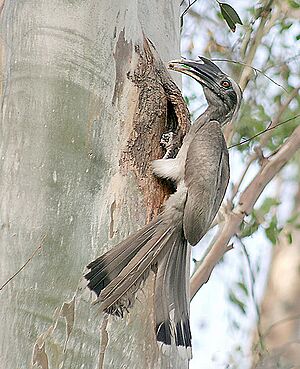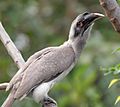Indian grey hornbill facts for kids
Quick facts for kids Indian grey hornbill |
|
|---|---|
 |
|
| Conservation status | |
| Scientific classification | |
| Genus: |
Ocyceros
|
| Species: |
birostris
|
| Synonyms | |
|
Lophoceros birostris |
|
The Indian grey hornbill (Ocyceros birostris) is a common bird found across the Indian subcontinent. These birds live mostly in trees. You can often see them in pairs. They have grey feathers all over their body. Their belly is a lighter grey or dull white. Their horn-like bill is black or dark grey. It has a special growth called a casque (pronounced "kask") on top. This casque extends to where the bill curves. Indian grey hornbills are one of the few hornbill types that live in cities. They use the large trees found along city streets.
Contents
What Does the Indian Grey Hornbill Look Like?
The Indian grey hornbill is a medium-sized bird. It is about 61 cm (24 in) (24 inches) long. Its upper body is greyish-brown. There is a faint pale line above its eye. The feathers covering its ears are darker. The wing feathers are dark brown with white tips. Its tail has a white tip and a dark band near the end. These birds have red eyes. Their eyelids even have eyelashes! The casque on their bill is short and pointed.
Differences Between Males and Females
Male hornbills have a larger casque on their dark bill. The top and bottom parts of their bill are yellowish. The skin around the male's eye is dark. Female hornbills have a more yellowish bill. The bottom half of their bill and their casque are black. The skin around the female's eye can sometimes be pale reddish.
Young Hornbills
Young hornbills, called juveniles, do not have a casque yet. The skin around their eyes is a dull orange color.
Where Do Indian Grey Hornbills Live?
You can find Indian grey hornbills mainly in flat areas. They live up to about 2,000 ft (610 m) (600 meters) above sea level. Their home range stretches from the foothills of the Himalayas in the north. It goes southwards across India. To the west, their range ends near the Indus River. To the east, it ends near the Ganges Delta.
These birds can even live in cities. They like places with old, large trees along the streets. They have been seen in pairs in Dharamsala, India. This was at about 1500 to 1600 meters (4900 to 5200 feet) high. This happened during the summer and rainy season in 2017. The Indian grey hornbill's home area does not overlap much with the Malabar grey hornbill, which lives in the Western Ghats.
How Do Indian Grey Hornbills Behave?
The Indian grey hornbill makes a squealing sound. It sounds a bit like a black kite. When they fly, it looks heavy. They flap their wings, then glide, then flap again. You usually see them in pairs or small groups.
Nesting and Reproduction
The nesting season for these birds is from April to June. A female hornbill lays one to five white eggs. These eggs are very perfectly shaped. Indian grey hornbills usually build their nests in hollows inside tall trees. They might dig out an existing hollow to make it bigger.
The female hornbill goes into the nest hollow. She then seals the nest hole. She uses her own droppings and mud pellets brought by the male. Only a small vertical slit is left open. Through this slit, the male feeds her. While inside the nest, the female loses her flight feathers. She also sits on the eggs to keep them warm. The male brings bark pieces to the nest. This helps to keep the nest clean. It also helps control the temperature inside. The female's new feathers grow back around the time the chicks are ready to leave the nest. At this point, the nest is broken open.
What Do They Eat?
A study near Mumbai looked at what these hornbills eat. They mainly ate fruits from trees like Streblus asper and Carissa carandas. They also ate fruits from Ficus species. Besides fruits, they also eat snails, scorpions, and insects. They have even been seen eating small birds. For example, they might eat rose-ringed parakeet chicks. They also eat reptiles. Interestingly, they can eat the fruits of Thevetia peruviana. These fruits are known to be poisonous to many other animals.
Daily Life
Indian grey hornbills spend almost all their time in trees. Very rarely, they come down to the ground. They might do this to pick up fallen fruits. They also come down to take a dust bath. Sometimes, they pick up mud pellets to seal their nest during nesting time. They do different social things together. This includes "bill-grappling," where they grab each other's bills. They also do "aerial jousting," which is like playing in the air.
Images for kids
-
At Uttarakhand, India
-
In Janakpur, Nepal
-
Indian Grey Hornbill in Pune. Note the casque, and the distinctive tail feathers.







